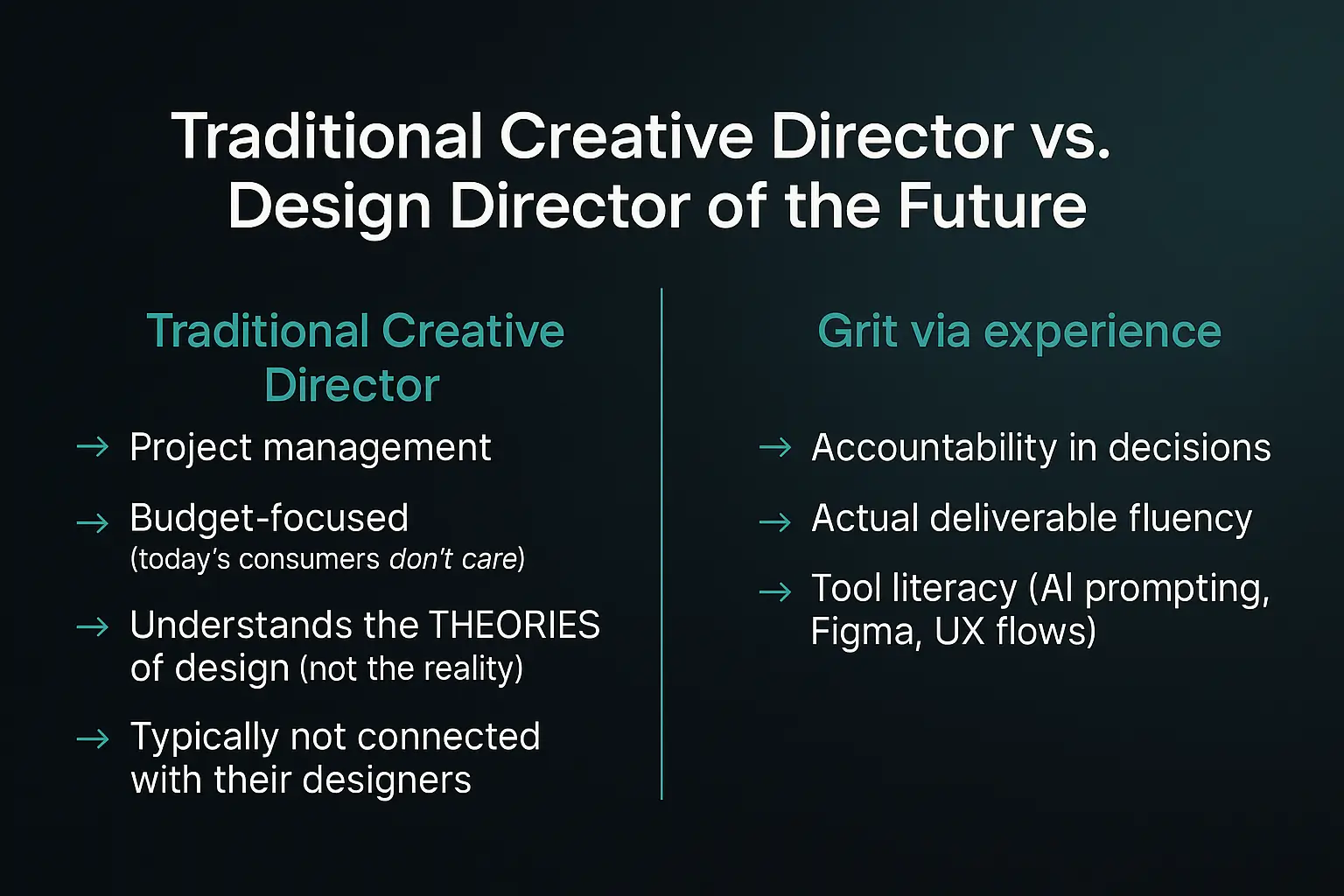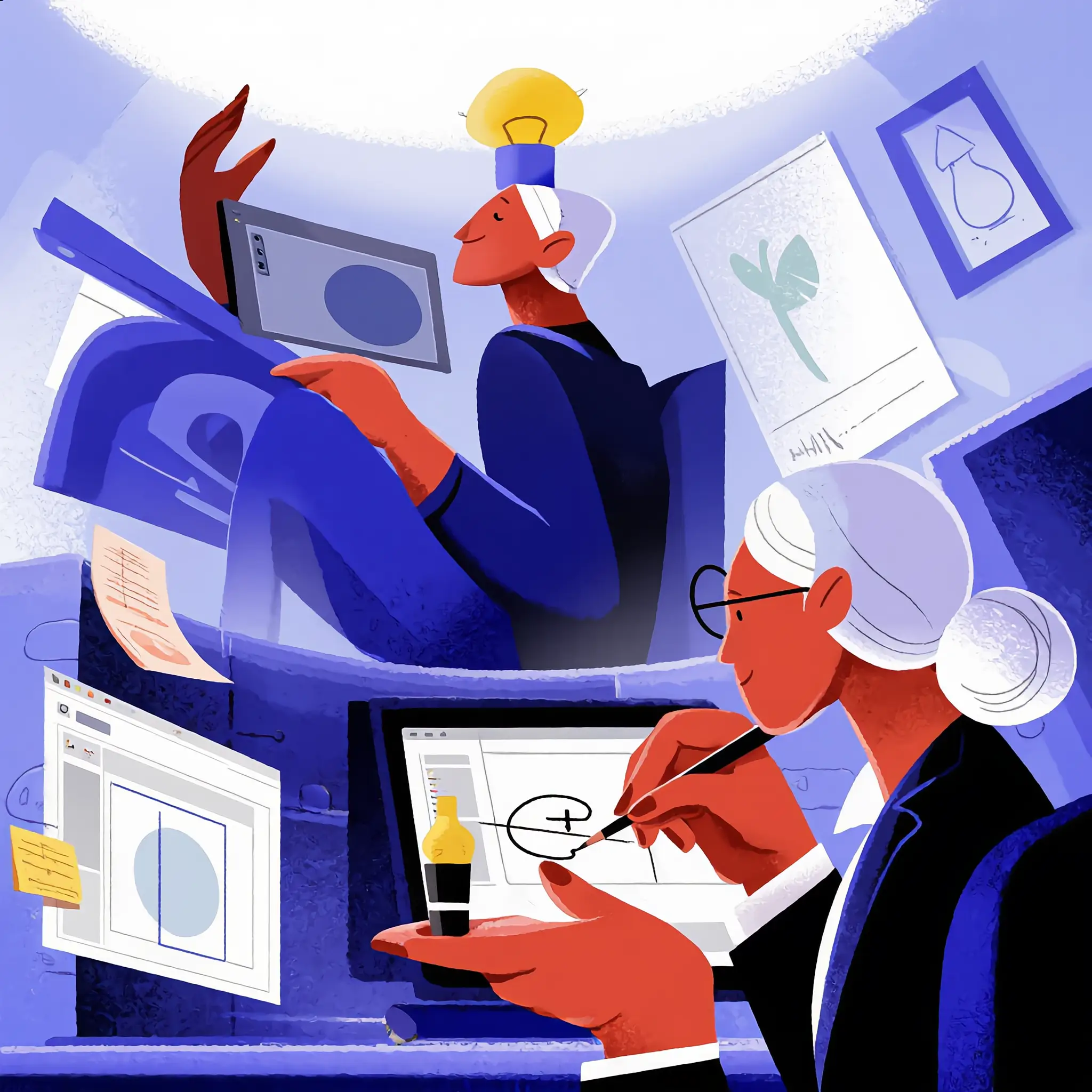From the Author
After decades in design, I chose leadership to keep crafting—pixels, motion, and those technical puzzles that make bold stories sing.
I can chart the big-picture vision and deliver on every KPI—that part’s expected. But the real art, the part that makes or breaks outcomes, is choreography.
It’s the ability to pull product, engineering, and brand into the same dance—each with their own rhythms, priorities, and pressures—and bring them into sync. When it works, decisions don’t just happen; they land with precision, like a beat that drops exactly where it should.
This is where design leadership goes beyond visuals. It’s about orchestrating alignment, building trust across silos, and making sure the story, the system, and the execution all move together. That’s how bold ideas become real-world results.
The real win is syncing our actions with strategy and impact: words matter, but how we move together decides if people come with us—or walk away. Whatever the title, that’s the job.
Compare and Contrast: Creative Directors vs. Design Directors
Creative leadership is evolving—fast. Job titles are stretching to fit a world powered by apps, AI, and accountability. Today’s creative leads must guide the work and move the numbers. That’s why the classic Creative Director and the “Next-Gen” Design Director now operate in entirely different modes—and modern teams can feel the gap.

The Traditional Creative Director—Our Classic Hero
Picture a storyteller in a sharp blazer, sketchpad in hand. This leader sets the big artistic vision for every poster, spot, and social ad. They write the creative rules (“Use this tone, keep the logo here”) and guard brand style like treasure. Most days, they’re dreaming up campaign themes, picking color palettes, and weaving brand stories across billboards, banners, and TV. They shine in brainstorms and client meetings, defending aesthetics with heart and history.
Craft and consistency are their north stars—but business impact? That’s usually someone else’s department.
The Design Director of “Now & Next”
Now swap that sketchpad for a sleek laptop—and add a toolbox full of AI, VR, AR, and real-time dashboards. This design leader still cares about craft but makes every decision with numbers in hand. They use AI to generate fast concepts, user data to validate direction, and systemized design tools to ensure scale and consistency.
Their mission is bigger than visual polish. They sit beside product and finance leads, transforming wild creative into measurable results—like faster checkouts or better onboarding. When a new tool drops, they’re first in line to test it. The future-ready Design Director blends artistry, technology, and strategic thinking to deliver what the business actually needs: outcomes.

Why New Design Hires Will Look Nothing Like the First
Market Reality: Digital experiences outpace campaign work 5:1—yet most job specs still read like it’s 2010.
Risk: Hiring a “logo-first” visionary when you need a product-literate growth driver stalls both revenue and morale.
Trailblazing Solution:
Start by tossing that VHS-era job spec. Instead, define the role around today’s workflow: rapid prototyping in Figma by 10 a.m., pulling retention data at noon, and briefing engineers before the stand-up. Look for portfolios that show how a micro-interaction boosted sign-ups, not just how a logo won an award. Give hybrid leaders clear OKRs and real cross-functional authority, and design will flip from cost center to growth engine—faster launches, happier users, and real business lift.
The Classic Agency CD Model Cracks Under Modern Pressure
In agile, SaaS, and omnichannel orgs, the waterfall mindset of traditional creative leadership leaves value on the table. According to McKinsey’s Business Value of Design study, companies in the top design quartile grow revenue nearly 2× faster than their peers. But NN/g reports that only 13% of design teams even have a DesignOps lead to scale that potential.
Translation: outdated roles aren’t the ceiling—outdated operating models are.
 Role Decoder: Creative Director vs. Design Director
Role Decoder: Creative Director vs. Design Director
Traditional Creative Directors are master storytellers. They lead with intuition, draw from design history, and build powerful campaigns with mood boards and flair. But they don’t always track how a font shift impacts checkout flow—or how a palette change boosts conversions. Their wins are based on creative strength and presentation polish, not on dashboards or cycle-time charts.
Modern Design Directors? They play a broader game. Every choice—layout, tone, micro-interaction—must clear three gates: user insight, technical feasibility, and business value. They test in Figma, validate with real feedback, and present results using the same KPIs the product team tracks.
Their toolkit includes cross-functional choreography. They sync with engineering timelines, flag resource issues to finance, and move from asking “Is it on-brand?” to “Will this ship Friday and improve retention?” Creativity still matters—it just now comes with metrics, velocity, and cross-team clarity.
Business Fluency Is Still a Differentiator
Future Design Directors are more than pixel wizards—they’re strategic partners. If you’re searching terms like “transition from designer to design director,” or “business skills for designers,” here’s the truth: today’s creative leaders need to understand market dynamics, competitive strategy, and product lifecycles. It’s no longer enough to create beautiful work; you must translate vision into business language and back it with results.
Designing with Dollars in Mind
Today’s Design Director watches pennies as closely as pixels. Before a sprint starts, they map every task to budget lines—hours, software fees, opportunity costs—and perform quick cost-benefit analysis to keep the work lean. During execution, they use live tracking tools, flag overruns early, and manage risk through contingency plans. By cutting waste and trimming design debt, they turn saved time into real ROI.
Measure What Matters
Intuition still matters—but it’s wrapped in data now. Design Directors use sprints tied to clear OKRs: NPS boosts, retention lifts, checkout gains. Progress lives in shared dashboards, not in presentation decks. By sprint’s end, the director can show a graph—not just a mockup—proving how design impacted the bottom line.
Let Data Do the Talking
Great leaders still tell stories—but now those stories include charts, heat maps, and real-time feedback. They explain why version A beat version B in language the CFO understands and the team can act on. The result: better approvals, sharper execution, and a team that knows exactly how their design choices perform.
AI in Design Teams Is a Non-Negotiable
Keeping Up with the Gates’ and AI Integration
Today’s creative leaders must be fluent in AI tools. It’s no longer optional—it’s operational. Design Directors must:
- Use generative AI for concept sprints
- Prompt tools like Midjourney and Firefly to deliver on-brand results
- Know when to hand the work back to humans for nuance and taste
- Integrate AI into everyday platforms (Figma, Adobe, generative testing)
AI helps teams ideate faster, reduce manual effort, and explore more concepts per sprint. The real leaders master it early and often.
Continuing to Learn: Tool Literacy Requirements
The divide between “creative lead” and “design executive” is now defined by tool mastery. Future-ready directors don’t wait on tech teams. They personally run:
- AI prompting platforms
- UX tools like Figma and Miro
- Design-system dashboards
- Data-viz tools for executive reporting
These tools aren’t flair—they’re how modern design teams stay ahead.
AI in Design: Nothing to Fear but Paranoia Itself

Generating 500 logo options with a prompt? Impressive. Picking the right one? That takes a director. Color psychology, market timing, user context—machines can crunch the data, yet only an experienced director asks the right follow-up questions: Does this shade motivate? Will that shape scale? AI delivers options; human wisdom delivers answers.
This is where the director’s role sharpens: interpreting nuance, filtering noise, and connecting design decisions to real-world outcomes like trust, engagement, and conversion.
The best directors treat AI as a rocket booster, not a co-pilot. They use it to accelerate idea generation, reduce repetition, and widen the sandbox for exploration. But at the end of the day, tech gives you options—only experience gives you direction.
Final Call: Embrace the Change
Leveling Up Your Creative Function
Tomorrow’s creative leaders balance artistry with analytics, vision with execution, and inspiration with ROI. Organizations that build these hybrid roles into their teams will innovate faster, compete better, and retain top talent. This isn’t a small shift—it’s a full rewrite of what design leadership really means. The future belongs to those who evolve.
To Aspiring Directors…Build Your Hybrid Edge
Want the top seat? Start now. Combine your creative eye with AI tools, user psychology, and business acumen. Learn to talk KPIs like you talk color. Master Figma, then learn how to translate design decisions into dollar signs. The future belongs to designers who blend intuition with insight—because when you become the hybrid, the market doesn’t just hire you…it chases you.